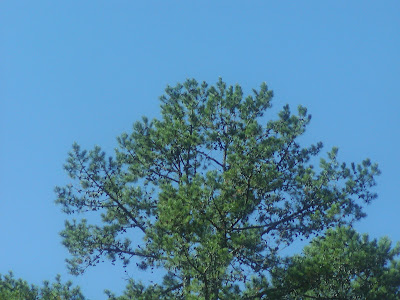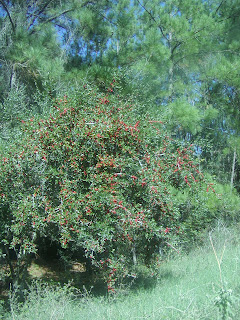A LINK WITH THE DRUIDS, Hawera & Normanby Star, Volume LXXI, 11 May 1912
"Many years ago, when the British wild ox roamed throughout the country, an occasional white calf would be born (says a writer in the Daily Mail). This, if not killed by its fellows, would be regarded as sacred by the ancient Britons, and carefully guarded when captured. The mating of these occasional freaks resulted, it is supposed, in the establishment of the white wild cattle in semi-captivity, such as the Chartley herd. Recently a few members of this old herd was established at the London Zoo, and once or twice a black calf has been born to the herd. Two of these interesting black "throw-backs" have been mated, and a black calf was born last week. This seems to point to the fact that we have got back to the beginning of a herd of the real ancient British ox. of which the white cattle, as we know them, are but the modern albino descendants."
Tracking down White Park cattle
by on December 6, 2011
"A current project coordinated by Rare Breeds International (RBI) is studying the degree of divergence between national populations. It already has demonstrated that descendants of cattle exported 50 years ago still have the same DNA profile as the current population in UK. In the course of this research RBI has discovered references in the twentieth century (1930s to 1990s) to White Park animals (also referred to as Park or English Park, and Ancient White Park in North America) in several zoological gardens in Europe, including Copenhagen, Prague, Riga, London and Berlin. We are interested to pursue further this thread of research to explore the possibility that the White Park was found more widely in zoological gardens. We request anyone with relevant information to contact RBI at rbisecretariat@mail.com and will be most grateful for your assistance."
 |
| This is a plate from a book published in the late 1890's and entitled 'White Cattle of Cadzow Park', and it is apparently a fraud. See the original below entitled 'Chillingham Cattle'. |
You decide, perhaps they would have better luck than I did in having the Bronx Zoo archives explored in regard to the Park Cattle that so very briefly called this zoo home -- but only if someone with 'veracity' accomplished that task.
By now in this 11th year of the 21st Century, the RBI certainly ought not to be suddenly surprised to learn that specimens of the breed were shipped to various locales across the world in their target time frame beginning in the 1930's - so I must say I am quite surprised at this RBI 'new' information and research focus - actually, I am quite skeptical and have to wonder at the motive of such naivete' from such an organization.
Please pay more attention than usual to the photos and their captions in this blog, as they are quite demonstrative of . . . well, lots of things that are quite pertinent historically to the much beloved ancient wild white cattle of Britain, both horned and polled -- and the veracity of the postulated history by pompous and influential individuals for well over 100 years of the laughable purity of horned Park cattle in comparison to polled Park cattle, or British White, as they are known today. Veracity - such a potent word when it comes to attempts to 'shape' any history . . .
The 1891 Grey Argus news article quoted below tells us that a heifer from the Chillingham herd and a bull from the Chartley herd were 'captured' and taken to the London Zoological Society as the first two representative animals of the 'wild white cattle' of Britain. They were to be used in a breeding program focused on trying to arrive at the 'original' type of wild white cattle.
We know that plans were in place to obtain specimens from several other wild white cattle herds of the late 19th century, including specimens from the polled Hamilton, Blickling and Somerford herds. This is highly pertinent to the ongoing stance of the horned Ancient White Park Cattle Association of the UK - and other flatulent and interested parties - which wish to establish the horned Park Cattle as the 'true' original and 'ancient' wild white cattle of Britain with NO genetic relationship to the polled British White cow of today:
"The Zoological Society will try to procure specimens from the other herds— Mr. Assheton-Smith's at Vaynol, the Duke of Hamilton's at Cadzow, Lady Lothian's at Blickling, and Sir Charles Shakerley's at Somerford, near Congleton." Grey River Argus 29 April 1891
"Zoologists hope by crossing the various strains to arrive at the original type, which is older than English civilisation and from which all these species are derived." Grey River Argus 29 April 1891
 |
| This 1835 drawing is entitled 'The White Urus' (or Hamilton breed of wild Cattle) and is a true Original drawing, and is available for purchase at this link: Prints Old and Rare. Note the polled cow. |
But, there is written proof of the result of a Vaynol and Chartley breeding (if in fact it was a Vaynol female):
"In the same house is a black calf of the Chartley X Vaynol blood, two abnormally colored calves having been thrown in succession by the same cow." Source: Science, Volume 28, October 16, 1908; By American Association for the Advancement of Science
 |
| This drawing dates from . . . hmm, no one knows except the perpetrator. It is a fraud, merely a colorized version of the original drawing of the Hamilton herd of wild Cattle, and re-named 'Chillingham Cattle'. It is available for purchase from Prints Old and Rare. |
There is some question as to whether the heifer was actually a Vaynol animal or one from the Chillingham herd. The story of the great furor created by the capture of the wild white heifer that was sent to the London Zoological Gardens refers in one article to its being captured from the Vaynol herd, and another of its being captured from the Chillingham herd. As the Grey River Argus article refers, as noted above, to the future plans to obtain a 'specimen' from the Vaynol herd, it seems more plausible that it was actually a Chilllingham heifer.
"A wild bull was presented from Lord Ferrers's herd at Chartley, near Uttoxeter, was presented to the gardens last summer, and a wild heifer from Lord Tankerville's herd at Chillingham has now been added." Grey River Argus 29 April 1891
This article is from the February 12, 1891, Timaru Herald and indicates two months prior that the heifer was from the Vaynol herd:
"Some notion, of the untameable nature of the 'wild white cattle', of which two interesting examples have lately been transferred to the Zoological Gardens, is to be gathered from Mr. J.E. Harding's account of the capture of the white heifer, which belonged to the famous herd Mr. Assheton-Smith's Park at Vaynol, near Bangor. These animals we are told, never suffer anyone to approach near enough to handle them."
"The heifer was lassoed in South American fashion, and it required the united efforts of five or six horsemen to prevent its rejoining the herd after it had been ridden out. Its bellowing then brought up its companions to the rescue, and it needed tact and care to prevent a charge and general stampede."
"Even when the herd had been successfully kept at bay, it required all the strength of five men to get the captive out of the park and into a loose box, where, as it had never before been under a roof, it remained for some days extremely wild and savage. It was eventually got into a strong deer cart, and thus was transported to the Zoological Society's grounds. Its companion, the young bull, came from Lord Ferrer's seat, Chartley Park, and represents a distinct type of this ancient breed."Here is a writer's observation of the Chartley bull in the Zoological Gardens in 1890:
This appears to be an original 1885 color lithograph of the Chillingham Cattle,
although I can't imagine how they could have got so very close to the so-called 'wild' cattle,
and is available for purchase from Prints Old and Rare. And the de-colorized
late 1890's book plate shown at the beginning of this blog as Cadzow cattle appears to be a fraud.
"Students of natural history are much interested by the latest arrival at the Zoological Gardens of the so-called "wild bull" from Chartley. In spite of its fierce name it is the mildest-looking little beast imaginable, very small, with a rough, white coat and black points . . . " (Agricultural and Pastoral News, 1890)
 |
| Does that cow above remind you in any way other than color of the same breed of cow in the old Chillingham lithograph just above? This is a March 2004 photo in Mother Earth News, and is representative of the horned 'Ancient' White Park Cows found in the USA today, and found by the referenced and recent study by the RBI to have the "same DNA profile" of those found in the UK today. What they don't mention is that yet again the horned White Park is found most closely related to the English Longhorn in that study, and that would be due to crossbreeding with English Longhorn, as well documented many years ago. |
 |
| This awesome painting is entitled "White Park Cattle", and was presented by the Plymouth artist, Carol Payne, to the Duke of Cornwall in June of 2010, and is found at the UK's "Field Day" blog. One comment was made on the blog: "That is a British White cow!" I'm guessing the Duke of Cornwall is well aware it is a 'white' Park cow that happens to be polled, and happens in the short term of history to have been labelled "British White". "He (the Duke of Cornwall) suggested one of two breeds and I chose White Park cattle." Since then Carol has researched the subject and "worked flat out day and night" to create the painting of a cow in a field of buttercups." |
 |
| This is a vintage postcard from 1903 available from CardCow.com entitled: Old English Wild Cattle, "A Somerford Park Cow" Compare this old postcard with the modern painting presented just above, and you decide just which type of ancient Park Cattle, polled or horned, have remained the most true to type of the breed of old . . . |
NEW MILKING RECORDS - BRITAIN'S WHITE CATTLE - THOUSAND-YEAR-OLD BREED
Tracking Down white Park Cattle . . . indeed it is always an interesting hunt!












